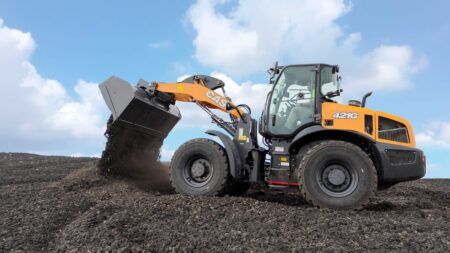There’s a renewed interest in hybrids
Since the first hybrid toe was tentatively dipped in the off-highway ocean, the technology has undergone rollercoaster levels of OEM interest, with very few high-profile launches even in prototype form in the past two or three years. So Intermat was notable for a slew of new innovations promising to deliver double-digit fuel savings.
Perhaps the most stylish of these was Hitachi’s ZW220HYB-5 (above), the company’s first mass production hybrid wheeled loader. Drawing on group technology proven in the bullet train and EH-series haul trucks, the ZW220HYB-5’s smaller than usual four-cylinder engine powers a generator, which produces energy to drive two electric travel motors. When the machine is rolling or braking, it continues to store electricity in a capacitor. Under acceleration, it draws on energy from the generator and the capacitor, meaning less RPM are required to reach normal travel speed. The control units are the key to the electrical power process and engine operation. For example, when lifting and loading, the engine RPM automatically increases in response to the load there is no need to use the accelerator pedal.
There are four main benefits of the hybrid system: reduced fuel consumption; enhanced reliability and safety; less noise; and easy operation. The ZW220HYB-5’s hybrid system will improve fuel efficiency by up to 26% compared to the previous conventional ZW220 wheel loader, while maintaining the same performance.
Meanwhile, Case Construction Equipment displayed the CX210 Hybrid, a medium-capacity prototype hybrid excavator that uses the same 160hp Isuzu T4i engine as its standard model, but in association with an electric motor acting as the swing device. Energy generated during the swing deceleration is converted and stored in the capacitor and used to assist the power of the engine via a generator motor. Although the cycle time of the hybrid remains the same, it enables greater fuel efficiency (+15%) and higher productivity.
This appears rather similar to the operating principle of Komatsu’s HB215LC-2 third-generation hybrid excavator (below) and there could be more to come from the Japanese OEM, as iVT discovered when asking Keiko Fujiwara, managing director and CEO of Komatsu Europe, about the company’s plans for the hybrid technology.
First launched in 2008 as the PC200-8, sales of the hybrid machine have steadily grown, with a working population of approximately 3,200 now in the field 220 of those in Europe and fuel savings now approaching 40%. So, given that proof of concept, we asked if it was now time to extend the reach of that technology. In short, the answer was, ‘Yes’, as Fujiwara revealed that development is currently ongoing to extend the technology to other sizes of excavators in the line-up. Though reluctant to reveal when we might see these launched, Peter Howe, managing director at Komatsu UK, suggested it would be reasonable to assume that development could be complete within one or two years.
And even the dealers are at it, as Manu Lorraine (above) highlighted with its modified hybrid Atlas 220W wheeled excavator, which is claimed to offer up to 50% fuel savings through use of the econergy solution, which offers a return on investment within 12-18 months. Unlike most other concepts on the market, this does not draw on swing technology at all, rather, it uses gravitational force from the lowering of the boom. The dead weight energy of the boom and empty bucket is recovered, using oil at the bottom of the recovery cylinder, and stored in a series of nitrogen accumulators. These, under the effect of the compressed gas, then release hydraulic oil according to the bucket’s activity and the recovered energy is then used to lift the weight of the arm, with the hydraulic pump only being needed to cover any energy shortfall to lift the load and cover any pressure drop in the hydraulic circuit.
And of course, the suppliers were also in evidence with their solutions. Dana (below), for instance, highlighted the Spicer PowerBoost hydraulic-hybrid system, which is now available for OEM field testing. Its own engineers have conducted extensive field tests of the system integrated with a dual-motor hydrostatic transmission in a series configuration. These tests of typical duty cycles have verified fuel savings of over 20% for a front-end loader, and over 25% on a telescopic boom handler, with an expected payback in under 18 months for both applications.
This technology is ideally suited for hydrostatically driven drivetrains, and works by capturing hydrostatic energy in an accumulator from the powertrain during low-power operation of the engine and when recuperated from braking.
Deployed through series or parallel hybrid configurations that fit into existing vehicle designs with minimal adaptation, it supplements all types of transmission architectures. It captures kinetic energy otherwise wasted throughout the drivetrain and working hydraulics and then uses this recuperated energy to help power the vehicle, which can reduce fuel consumption by 20-40% compared with conventional drivetrain concepts.
When additional power is required, such as accelerating from stationary, lifting a load, or driving into the pile, the advanced energy-management system uses the stored energy in the accumulator to provide an additional source of power for improving performance, increasing productivity, and reducing fuel consumption.
It can also be configured to minimize engine idling by shutting off the diesel engine and accessing power captured in the accumulator for vehicle operations that consume low amounts of energy.
Last but not least, John Deere Electronic Solutions (JDES) introduced the PD400 modular inverter for high-voltage/high-power hybrid electric vehicles (above). The all-in-one solution eliminates the need for multiple interfaces while matching exact system requirements, simplifying work, and allowing system designers to optimize machine performance in extreme conditions in off-highway and heavy duty applications.
The new PD400 modular design can be configured with a single or dual inverter, optional brake chopper, optional DC-DC converter, and an available integrated isolation monitoring feature. It also eliminates multiple connector and cooling interfaces to improve cost, minimize space requirements, and reduce losses for improved efficiency.
The PD400 has a common electronic control architecture that supports the full suite of JDES advanced motor control software to optimize performance of permanent magnet or induction motors in hybrid electric applications. PD400 software is designed to work at maximum efficiency with complete monitoring capabilities to enable precise control under various operating conditions. The thermal management system is liquid-cooled for robust and reliable performance over the life of the system.
May 8, 2015




